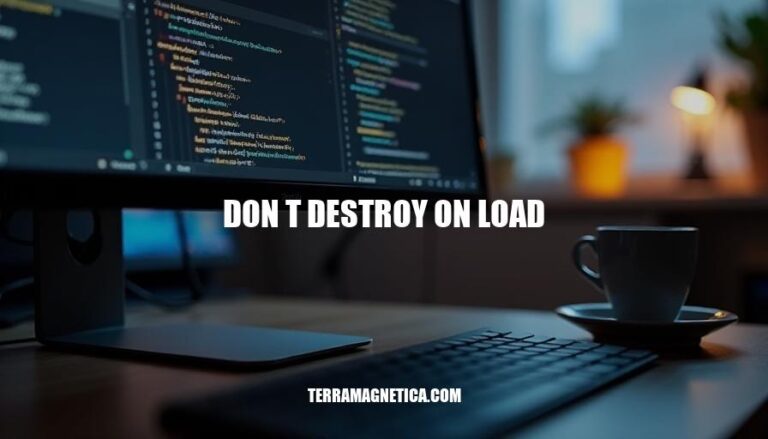


In Unity, the DontDestroyOnLoad function is used to prevent specific GameObjects from being destroyed when a new scene is loaded. This is particularly important for objects that need to persist across multiple scenes, such as game managers, audio sources, or player data. By using DontDestroyOnLoad, developers can ensure that essential data and functionalities remain intact throughout the game, enhancing the overall user experience and maintaining game state consistency.
Don’t Destroy On Load is a Unity function that prevents a game object from being destroyed when a new scene is loaded. This is useful for preserving objects like game managers, audio sources, or player data across different scenes.
To use it, you call DontDestroyOnLoad(this.gameObject); in the script attached to the game object you want to keep. This ensures the object remains active and intact even as you switch scenes.
Here are the steps to implement DontDestroyOnLoad in a Unity project, along with code examples and best practices:
DontDestroyOnLoadCreate a Script:
DontDestroy.cs.Add the DontDestroyOnLoad Method:
DontDestroyOnLoad method to the Awake function to ensure the GameObject persists across scenes.Singleton Pattern (Optional but Recommended):
using UnityEngine;
public class DontDestroy : MonoBehaviour
{
private static DontDestroy instance;
private void Awake()
{
if (instance == null)
{
instance = this;
DontDestroyOnLoad(gameObject);
}
else
{
Destroy(gameObject);
}
}
}
Use Singleton Pattern:
Initialization Scene:
DontDestroyOnLoad objects. This scene should never be loaded again.Avoid Direct Scene References:
DontDestroyOnLoad objects directly in scenes. Instead, instantiate them via scripts to maintain control over their lifecycle.Use Prefabs:
DontDestroyOnLoad objects to manage them easily and ensure consistency across scenes.Testing:
By following these steps and best practices, you can effectively implement DontDestroyOnLoad in your Unity project to maintain GameObjects across scene loads.
Here are some common scenarios where using DontDestroyOnLoad in Unity is beneficial:
Player Data: Keeping player stats, inventory, or progress intact across different scenes. This ensures that the player’s data is consistent and doesn’t reset when transitioning between levels.
Game Settings: Maintaining settings like audio levels, graphics preferences, or control mappings. This allows for a seamless experience where the player’s preferences are preserved throughout the game.
Game Managers: Persisting game management objects such as score managers, achievement trackers, or event systems. These objects often need to be accessible and consistent across multiple scenes to manage game-wide states and events.
Networking: Keeping network-related objects, like connection managers or player network identities, alive across scenes. This is crucial for maintaining stable multiplayer sessions without disconnecting players during scene transitions.
Audio: Ensuring background music or sound effects continue playing without interruption when moving between scenes. This helps maintain the game’s atmosphere and immersion.
These scenarios leverage DontDestroyOnLoad to enhance the player’s experience by providing continuity and consistency throughout the game.
Here are some potential issues and pitfalls when using Don'tDestroyOnLoad in Unity, along with ways to avoid them:
Duplicate Objects:
Don'tDestroyOnLoad is called multiple times.Memory Leaks:
Scene Management:
Event Subscriptions:
Parent-Child Relationships:
Don'tDestroyOnLoad object may not behave as expected.Don'tDestroyOnLoad.Initialization Order:
By being mindful of these pitfalls and implementing the suggested avoidance strategies, you can effectively use Don'tDestroyOnLoad without running into common issues.
Here are some advanced techniques and tips for optimizing the use of DontDestroyOnLoad in complex Unity projects:
Singleton Pattern: Implement a Singleton pattern to ensure only one instance of a game object persists across scenes. This helps avoid duplicates and ensures consistent state management.
public class GameManager : MonoBehaviour
{
private static GameManager instance;
void Awake()
{
if (instance == null)
{
instance = this;
DontDestroyOnLoad(gameObject);
}
else
{
Destroy(gameObject);
}
}
}
RuntimeInitializeOnLoadMethod Attribute: Use this attribute to initialize objects at runtime without needing them in the initial scene.
public class Initializer
{
[RuntimeInitializeOnLoadMethod(RuntimeInitializeLoadType.BeforeSceneLoad)]
static void OnBeforeSceneLoad()
{
GameObject obj = new GameObject("PersistentObject");
obj.AddComponent<PersistentComponent>();
DontDestroyOnLoad(obj);
}
}
Avoiding Nested DDOL Objects: Ensure DontDestroyOnLoad objects are not nested under other objects that might be destroyed. Detach them from their parent before applying DontDestroyOnLoad.
void Start()
{
transform.parent = null;
DontDestroyOnLoad(gameObject);
}
Managing Scene Transitions: Carefully manage scene transitions to avoid unintended behavior. For example, use a loading screen or intermediate scene to handle transitions smoothly.
Performance Considerations: Minimize the number of DontDestroyOnLoad objects to avoid performance overhead. Only use it for essential objects like game managers, audio managers, etc.
Debugging and Testing: Regularly test and debug to ensure DontDestroyOnLoad objects are functioning as expected. Use logging to track the lifecycle of these objects.
These techniques can help you effectively manage persistent objects in your Unity projects, ensuring smooth transitions and consistent game states.
is a Unity feature that allows certain objects to persist across scene changes, ensuring a seamless gaming experience.
To effectively use DDOL, it’s essential to understand its limitations and potential pitfalls. Common issues include object duplication, initialization order problems, and performance overhead.
To avoid these issues, implement the Singleton pattern for persistent game managers, use the RuntimeInitializeOnLoadMethod attribute for runtime initialization, detach nested objects from their parents before applying DDOL, manage scene transitions carefully, minimize the number of DDOL objects, and regularly test and debug to ensure smooth functionality.
By following these best practices, developers can create engaging games with consistent state management and efficient performance.